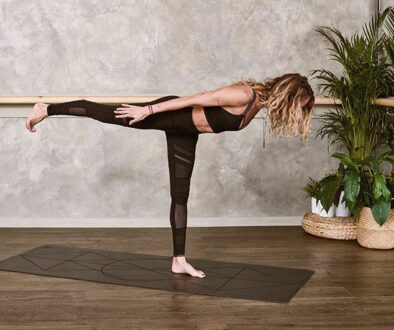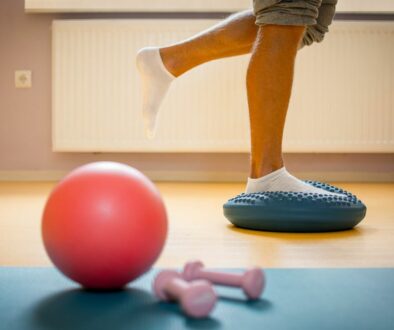4 activités pour travailler sa proprioception
Connaissez-vous la proprioception ? Comment peut-on la travailler ? Quel type de matériel est nécessaire ? Comment développer son équilibre grâce au sens proprioceptif ? Que vous soyez dans une logique de rééducation proprioceptive ou bien par désir de prévention de blessures, découvrez tous nos conseils d’exercices de proprioception.
Qu’est-ce que la proprioception ?
En lisant cet article, on espère répondre à la question que vous vous posez : qu’est-ce que la proprioception ? Chacun de nous possèdent des récepteurs sensoriels qui nous permettent de réagir, de comprendre et de nous organiser face aux évènements et objets qui nous entourent.
Ces récepteurs sensoriels répondent de manière adaptée aux sollicitations perçues dans notre environnement. Organisés sous forme de stimuli, la réponse de ces récepteurs se base sur les 7 systèmes sensoriels classiques : visuel, tactile, auditif, olfactif, gustatif, vestibulaire et proprioceptif.
La proprioception est un système sensoriel qui désigne la représentation et la perception dans l’espace de la position des différentes parties du corps de chacun. Si l’on décompose la composition du mot, on remarque que les mots “propre” et “perception” définissent bien ce qu’est la proprioception : savoir où est son corps et comment il bouge. C’est un sens qui est étroitement lié au sens de l’équilibre.
Ainsi, les récepteurs sensoriels proprioceptifs, positionnés dans les muscles, les articulations et les ligaments, peuvent s’organiser face à une activité physique qui stimule les articulations (sauter, ramper, rouler, tomber, courir, marcher), la force soutenue (soulever et porter un objet lourd), la force dynamique (pousser ou tirer quelque chose, faire des pompes), la pression profonde sur les muscles (objet lourd, massage). C’est la réaction du cerveau face à ces stimuli qui définit comment les muscles doivent réagir en fonction de l’objectif désiré : soit se contracter, soit se détendre.
Plus globalement, la proprioception se retrouve dans nombreuses de nos activités physiques du quotidien et de loisirs. Il est aussi possible d’augmenter la capacité proprioceptive en effectuant des exercices spécifiques. En exerçant ce sens de l’équilibre de manière régulière, c’est la qualité et la réactivité du traitement des informations entre le corps et le cerveau qui sont améliorés. Le système sensoriel communique mieux avec le système nerveux. La conséquence principale est sans appel, le risque de blessure est largement diminué. Pour en savoir plus, découvrez notre guide complet sur la proprioception.
Comment travailler la proprioception ?
La musculation
La musculation peut être une pratique physique idéale si vous souhaitez stimuler votre proprioception et votre renforcement musculaire. Parmi les nombreux exercices physiques conseillés par les professionnels de santé, vous pouvez vous focaliser sur l’exécution des fentes, des squats sautés mais aussi des pompes. Le tout accompagné de quelques poids afin de rajouter de la difficulté à votre effort physique.
N’hésitez pas à contrôler vos gestes pour optimiser le travail proprioceptif. Servez-vous d’un miroir pour visualiser si vous effectuez correctement les gestes

Les exercices d’équilibre
Un entraînement proprioceptif peut s’intégrer de manière intuitive dans le quotidien de chacun. Il suffit de rajouter de l’équilibre à chaque geste du quotidien : mettre ses chaussettes debout, se tenir en équilibre pour cuisiner, faire du lancer de balle sur un pied, marcher à cloche-pieds ou encore en fermant les yeux.
En effectuant vos exercices de proprioception, penser à travailler pieds nus et à varier la difficulté (équilibre statique ou dynamique, les yeux ouverts ou fermés). Pensez à conserver une posture optimale avec un bon alignement de la colonne vertébrale, de la tête et du bassin.
De plus, en associant le gainage à vos exercices de proprioception, vous allez pouvoir renforcer votre posture. Ne lésignez par sur la réalisation de quelques exercices de gainage si vous souhaitez faire progresser votre proprioception.
Afin de compléter les exercices sans matériel, des outils proprioceptifs peuvent vous permettre d’effectuer des exercices d’équilibre efficaces et sans trop d’efforts de recherche.

- Les planches d’équilibres :
Travailler sur une planche d’équilibre possède de nombreux avantages et n’est pas exclusivement réservé aux kinésithérapeutes. Simple d’utilisation, le « bosu » ou la planche d’équilibre est très efficace pour développer la gestion de l’équilibre. Comme vu précédemment, n’hésitez pas à ajouter de la difficulté en fermant les yeux ou bien en jonglant, en effectuant des squats, etc.
- La slackline :
C’est l’outil qui peut dynamiser votre équilibre ! Ludique, cette activité de plein air peut vous occuper pendant des heures. A vous d’adapter la hauteur et la difficulté en fonction de votre niveau. Vous pouvez varier la vitesse de marche, vous chronométrer mais aussi tenter d’effectuer quelques figures techniques pour rajouter plus de difficulté sur la slackline. Encore mieux, si l’espace vous le permet, essayez de faire des courses avec vos amis.
- Les tabourets dynamiques :
La majorité des tabourets ergonomiques proposent une fonctionnalité d’assise réglable et dynamique. Dans ce sens, le travail proprioceptif s’intègre plus facilement sur une position assise et réduit la position assise statique.
Des tabourets comme le siege ergonomique ActiveBase, sont recommandés pour réduire les maux de dos et favoriser la position dynamique en étant assis.
L’accrobranche
Parfait pour celles et ceux qui aiment grimper aux arbres et prendre de la hauteur, l’accrobranche est une activité physique qui va permettre de travailler la proprioception en pleine nature. Prenez votre temps dans les ponts suspendus, les filets ou encore les rondins vont vous aider à développer la technique de votre capacité proprioceptive.

Courir sur terrain accidenté
Alliez course à pied et proprioception en courant sur des chemins accidentés. Moins stables que les surfaces lisses comme les pistes ou la route, ces sentiers vont être un bon entrainement pour améliorer votre proprioception tout en développant votre renforcement musculaire.
Attention, veillez à être bien équipé pour ce type d’activités physique et proprioceptive. Des chaussures de trail avec un bon maintien du pied seront indispensables. N’essayez pas non plus de courir à grandes enjambées pour réduire les risques de chutes. Gardez vos mains prêtes pour vous rattraper en cas de chutes à terre. Plus le terrain est pentu et accidenté, plus la proprioception sera sollicitée.





